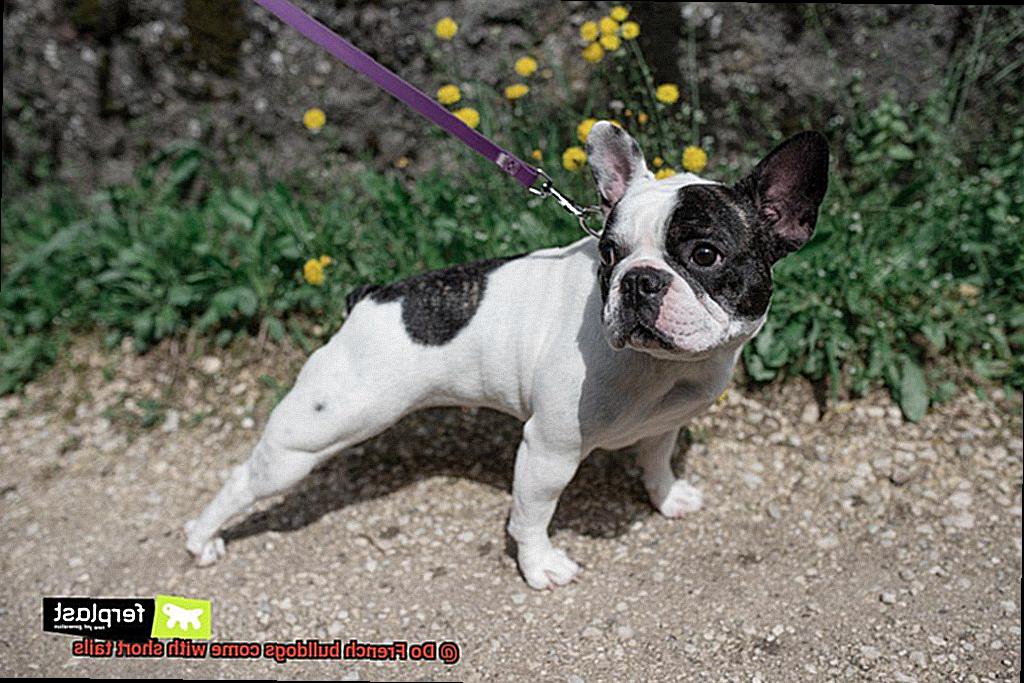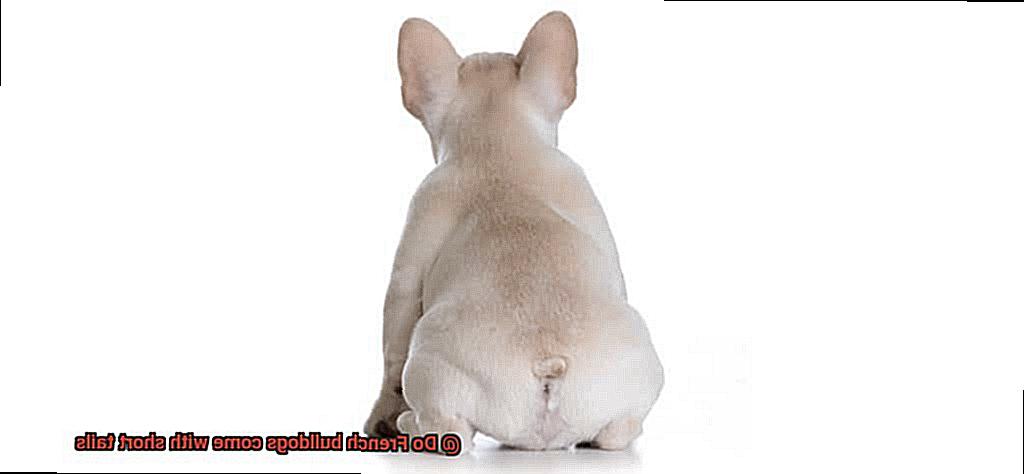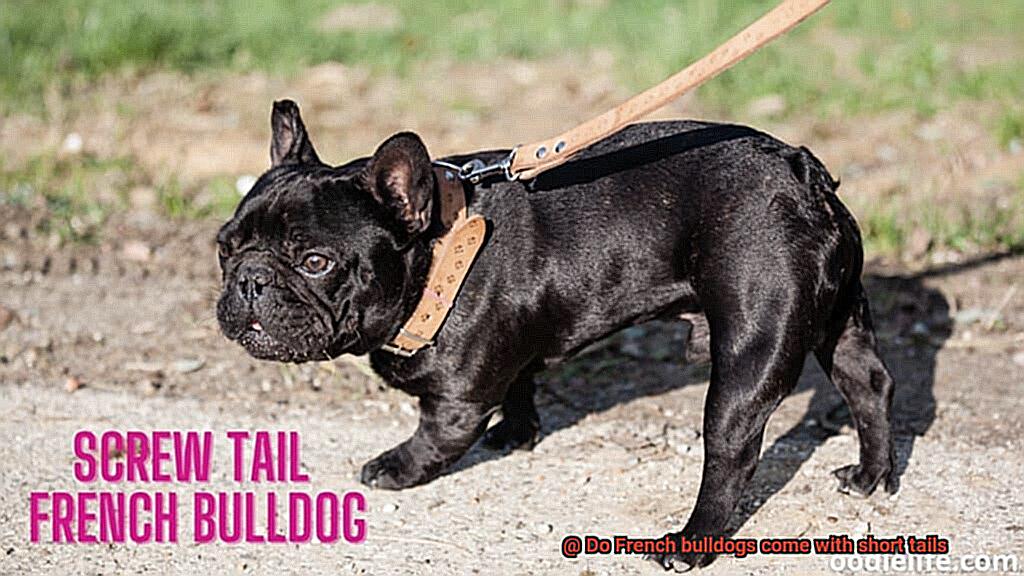Do French bulldogs come with short tails?
French bulldogs, those irresistible little creatures who have stolen hearts all over the globe, are famous for their distinctive looks.
With their squishy faces, pointy bat-like ears, and compact bodies, they’re like walking bundles of cuteness. And let’s not forget about their tails – or lack thereof.
Yes, Frenchies come with short tails that will make you go “aww” in an instant. But have you ever wondered why?

We’ll explore everything from genetics to history to practical reasons that contribute to our beloved Frenchies’ adorable little nubs.
So, buckle up and prepare to be both educated and entertained as we dive into this tail-wagging adventure together.
What is the Standard Tail Length for French Bulldogs?
Contents
- 1 What is the Standard Tail Length for French Bulldogs?
- 2 Variation in Tail Length among French Bulldogs
- 3 The Genetics Behind Longer Tails in French Bulldogs
- 4 Why Some French Bulldogs Have Shorter Tails
- 5 The Controversy Surrounding Tail Docking
- 6 What to Consider When Choosing a French Bulldog Puppy
- 7 Tips for Caring for a French Bulldog with a Longer Tail
- 8 Conclusion
French Bulldogs captivate us with their distinctive charm, and their tail length is often a topic of discussion. In this article, we will delve into the world of French Bulldog tail lengths and uncover the standard guidelines.
Whether you’re a proud owner or an enthusiast, this information will help you understand this unique breed even better.
Understanding the Breed Standard:
As per reputable kennel clubs like the American Kennel Club (AKC), French Bulldogs should possess an “undocked, short, low-set tail, thick at the root, and tapering quickly to a fine point.” This means that their tails are naturally short and straight, carried low without any curling over the back. It’s this distinct tail characteristic that adds to their overall appeal.
Variations in Tail Length:
While most French Bulldogs possess the characteristic short tail described in breed standards, there can be some variation within the breed. Some French Bulldogs may have slightly longer tails, ranging from just a little longer to significantly longer, resembling the tail length of other dog breeds.
However, as long as these tails adhere to the described shape and structure, they are still considered within the breed standard.
Tail Docking Controversy:
It’s essential to note that some breeders may choose to dock the tails of French Bulldog puppies. Tail docking involves surgically removing a portion of the tail to achieve a shorter length. However, this practice is controversial and illegal in many countries due to concerns about animal welfare. It’s crucial to prioritize the well-being of these delightful companions above aesthetic preferences.
Tips for Responsible Ownership:
When considering a French Bulldog as a pet, responsible ownership is paramount. Prioritize health and well-being over cosmetic ideals. Consult with a reputable breeder or veterinarian who adheres to ethical breeding practices. They can provide accurate information about tail length and any specific concerns related to this breed, ensuring you make an informed decision.

Variation in Tail Length among French Bulldogs
Today, we embark on a journey to explore the fascinating world of tail lengths among our beloved furry friends. From genetics to breeding practices, we’ll uncover the factors that contribute to the variation in tail length and shed light on the health implications associated with these differences.
Genetics: The Building Blocks of Tail Length
In the intricate tapestry of a French Bulldog’s DNA, specific genes hold the key to tail length. These genetic codes determine whether a pup will flaunt a short or long tail. Breeders, like skilled artisans, carefully select dogs with desired tail characteristics to ensure consistent tail lengths in their litters. But even genetics can unleash surprises, gifting us with adorable Frenchies whose tails deviate from the breed standard.
Breeding Practices: The Artistry and Accidental Variations
Responsible breeders strive to paint a portrait of perfection, adhering to the breed standard that calls for a short and tapered tail in French Bulldogs. Yet, in the realm of creation, some breeders may prioritize other traits, inadvertently giving rise to variations in tail length.
It is crucial for both breeders and prospective owners to appreciate the importance of selecting dogs with desirable tail traits during the meticulous breeding process.
Nature vs. Nurture: The Dance of Environmental Factors
Nature may hold sway, but nurture also has its say in the realm of tail length variations. Inadequate nutrition during pregnancy or early growth stages can stunt or alter tail growth, leaving us with tails that sing a different tune.
Additionally, trauma or injury to the tail can rearrange its length and appearance, altering the symphony of tail variation. By providing optimal nutrition and preventing tail injuries, we can compose a harmonious melody of healthy tail development.
Health Implications: The Symphony of Well-being
Fear not, dear readers, for different tail lengths do not compose a dirge of ill health for your Frenchie. However, vigilant eyes must watch for any discordant notes such as kinks or malformations, as they may hint at underlying spinal issues. Regular veterinary check-ups and attentive observation serve as the conductor’s baton, ensuring your Frenchie’s tail remains a happy and healthy part of its symphony.
Tail Docking: A Controversial Overture
Once a common practice, it now stirs controversy and draws the curtain on ethical concerns. The decision to dock a French Bulldog’s tail requires a delicate dance with a veterinarian, taking into account individual circumstances and bowing to local laws and regulations that govern this performance.
The Genetics Behind Longer Tails in French Bulldogs
Today, we embark on a genetic exploration into the world of our beloved furry companions, delving into the secrets behind their varying tail lengths. So, grab a steaming cup of coffee, settle in, and prepare to unravel the intricate genetics that determine longer tails in French Bulldogs.
The Dominant T Gene and the Recessive t Gene:
At the core of this genetic narrative lies the T gene, aptly named the “short-tail gene.” This gene has two forms: the dominant form (T), which results in a short tail, and the recessive form (t), which allows for a longer tail. If both parents carry the recessive t gene, there is an increased likelihood of producing French Bulldog puppies with longer tails.
The Complex Symphony of Genes:
While the T gene plays a vital role, it is crucial to acknowledge that other genes and factors can also influence tail length. Like an intricately choreographed ballet, these genes interact in a complex dance to determine the final outcome. This complexity means that not all puppies from parents with the recessive t gene will inherit the longer tail trait.
Selective Breeding and Breed Standards:
Over time, breeders have selectively bred for shorter tails in French Bulldogs to align with breed standards and preferences. This intentional breeding has contributed to the prevalence of short-tailed French Bulldogs that we commonly see today. Nonetheless, nature delights in surprising us, and longer-tailed French Bulldogs can still make their delightful appearances.
Unraveling the Genetic Puzzle:
To gain a deeper understanding of your French Bulldog’s potential for longer tails, genetic testing can provide valuable insights. This testing identifies whether your furry companion carries the recessive form of the T gene, shedding light on their tail length inheritance.
Conclusion:
As we conclude this captivating journey through the labyrinthine genetics of French Bulldog tail lengths, we hope you have gained a profound appreciation for the intricate interplay of genes that determine these delightful pups’ tails. Whether your French Bulldog flaunts a short or long tail, embrace their uniqueness and shower them with unconditional love.
Why Some French Bulldogs Have Shorter Tails
Have you ever pondered the reason behind why some French Bulldogs sport shorter tails while others flaunt longer ones? Prepare yourself for an enlightening adventure as we uncover the secrets.
Let us begin by delving into the captivating realm of genetics. The breed standard for French Bulldogs dictates a naturally short and straight tail, affectionately known as a “screw tail”.
This delightful characteristic can be traced back to the breed’s distinguished ancestors, such as the English Bulldog and the Toy Bulldog, who also boasted naturally short tails.
Over time, this remarkable trait has been carefully preserved through selective breeding, resulting in the iconic short tail that captures our hearts today.
However, not all French Bulldogs adhere to this standard. Genetic variations may occur, leading to individuals with longer or more elegantly curved tails. These variations may be the result of natural mutations or crossbreeding with other breeds that possess different tail characteristics.
So, if your French Bulldog sports a longer tail, it simply means they have inherited a unique combination of genes that sets them apart.
Now, let us turn our attention to another fascinating factor contributing to shorter tails in French Bulldogs: a condition known as brachyury.
This captivating genetic mutation affects the development of the tail vertebrae, resulting in a shorter or even absent tail. It is important to note that brachyury is not exclusive to French Bulldogs and can manifest in other dog breeds as well.
Next on our agenda is the controversial topic of tail docking. Tail docking involves surgically removing a portion of the tail shortly after birth.
While this practice was historically carried out for practical reasons, such as preventing injuries during hunting or working activities, it is now considered illegal in many countries.
Tail docking should only be performed for valid medical reasons and under the expert care of a licensed veterinarian.
On the flip side, some French Bulldogs are fortunate enough to be born with naturally short tails, without any genetic or surgical interventions. These enchanting creatures are often referred to as “natural bobtails” and owe their unique attribute to spontaneous genetic mutations that result in an unusually short tail or the absence of a tail altogether.
It is crucial to bear in mind that regardless of their tail length, French Bulldogs are capable of leading joyous and healthy lives. The length of their tails does not hinder their ability to communicate or balance, as they primarily rely on other forms of body language to convey their thoughts and emotions.
The Controversy Surrounding Tail Docking
Tail docking, a surgical procedure performed on puppies at just a few days old, has a long history. Originally, it served functional purposes such as preventing tail injuries during hunting and fighting.
However, in today’s world, tail docking has shifted towards an aesthetic practice aimed at conforming to breed standards set by kennel clubs and show organizations.
The Ethical Dilemma:
Critics vehemently oppose tail docking on ethical grounds. They view it as a painful and unnecessary procedure that inflicts physical and psychological harm on dogs.
For them, dogs are born with tails for a reason – to communicate and express themselves. Removing their tails is seen as an act of mutilation, interfering with their natural behaviors and abilities.

The Legal Perspective:
Amidst this controversy, some countries have banned tail docking entirely, considering it an act of animal cruelty. However, other nations still permit the practice for certain breeds, like the French Bulldog.
This legal divide further fuels the debate among dog owners, breeders, veterinarians, and animal welfare organizations.
Supporters’ Arguments:
Proponents of tail docking argue that it is necessary to maintain breed standards and prevent potential injuries. French Bulldogs, for instance, are prone to tail injuries due to their short and screw-shaped tails.
Supporters claim that docking at an early age minimizes pain and discomfort since puppies’ nervous systems are not fully developed.
Alternative Solutions:
Opponents counter these arguments by suggesting alternative methods to protect dogs’ tails. They propose responsible breeding practices and educating dog owners about proper tail care.
In some cases, breeders may opt for more humane alternatives like banding or splinting the tail instead of docking it.
What to Consider When Choosing a French Bulldog Puppy
Bringing home a French Bulldog puppy is an exciting and life-changing decision. These adorable and affectionate dogs make wonderful companions, but it’s important to choose the right puppy for your family.
In this guide, we’ll explore the essential factors to consider when selecting a French Bulldog puppy, ensuring that you find a healthy and well-suited furry friend.
Health and Genetic Testing:
The health of your French Bulldog puppy should be a top priority. French Bulldogs are prone to certain health issues, such as breathing difficulties and joint problems. When choosing a puppy, ask the breeder about the health history of both the puppy’s parents and inquire about any genetic testing that has been done. This information will give you peace of mind and help you select a healthy puppy.
Temperament:
French Bulldogs are known for their friendly and playful nature. Spend time with the litter and observe their behaviors. Look for puppies that are confident, curious, and show no signs of fear or aggression. A well-socialized puppy will adapt easily to your family and be easier to train.
Reputable Breeder:

Choosing a reputable breeder is crucial in ensuring that you bring home a healthy and well-adjusted puppy. Look for breeders who prioritize the well-being of their dogs, provide proper care and socialization, and have knowledge about the breed. Research the breeder’s reputation by reading reviews and asking for referrals.
Physical Characteristics:
French Bulldogs have unique physical features that contribute to their charm. Take note of the puppy’s body structure, head shape, and size of their ears. Ensure that the puppy has clear breathing patterns, as respiratory issues can be common in this breed. Look out for any visible signs of health problems like skin issues or eye abnormalities.
Lifestyle Compatibility:
Consider your lifestyle and how well a French Bulldog puppy will fit into it. French Bulldogs are generally low-energy dogs that adapt well to apartment living, but they still require regular exercise and mental stimulation. Make sure you can provide them with the care and attention they need.
Tips for Caring for a French Bulldog with a Longer Tail
French Bulldogs are adored for their unique appearance, including their short, stubby tails. However, some French Bulldogs have longer tails, which require special care and attention.
Here, we will explore the importance of providing gentle care, regular grooming, a safe environment, and seeking veterinary attention when caring for a French Bulldog with a longer tail. By following these tips, you can ensure that your furry friend’s tail remains healthy and they live a happy and comfortable life.
Gentle Handling:
When handling a French Bulldog with a longer tail, it is crucial to be gentle and cautious. Their tails are more susceptible to injury or getting caught in objects due to their length.
Avoid pulling or hurting their tail accidentally by being mindful of how you pick them up or engage in playtime together. Treat their tail with the same care and tenderness as you would any other part of their body.
Regular Grooming:
Regular grooming is essential for French Bulldogs with longer tails. Brush their tail regularly to prevent tangles and mats from forming, which can be painful for your furry companion.
Additionally, clean their tail regularly to keep it free from dirt or moisture that can lead to infections or skin irritations. Pay attention to any signs of discomfort or tenderness during grooming and adjust your approach accordingly.
Safe Environment:
Creating a safe environment is paramount when caring for a French Bulldog with a longer tail. Remove any sharp objects or furniture with sharp edges that could potentially harm their tail.
Be mindful of placing them in situations where their tail may get caught in tight spaces or furniture. Providing a spacious and clutter-free living area will minimize the risk of accidents or injuries.
Exercise Considerations:
Although French Bulldogs do not require excessive exercise, it is important to provide them with regular physical activity. However, be mindful of activities that may strain their tail, such as excessive jumping or rough play.
Opt for low-impact exercises like short walks or gentle play sessions to keep them active without putting unnecessary strain on their tail.
Veterinary Attention:
Regular veterinary check-ups are crucial for monitoring the overall health of your French Bulldog, including their tail. Seek professional advice on specific tail care needs based on your dog’s individual requirements.
Your veterinarian can provide guidance on any potential issues or concerns and offer appropriate treatment options if necessary.
zFI6f_Kx8Ac” >
Conclusion
In conclusion, French Bulldogs are indeed blessed with short tails, in accordance with the breed standard. These little tail wonders are naturally short, sitting low and straight, adding an extra touch of charm to their already distinctive appearance.
While the majority of French Bulldogs sport this signature stubby tail, there can be some delightful variations within the breed. Some may possess tails that are slightly longer, yet still maintain the described shape and structure.
It’s crucial to acknowledge that tail docking, a practice involving the surgical removal of a portion of the tail, has sparked controversy and is deemed illegal in numerous countries due to concerns surrounding animal welfare. Responsible ownership places health and well-being above mere aesthetics and seeks guidance from reputable breeders or veterinarians who uphold ethical breeding practices.
The length of a French Bulldog’s tail is determined by genetics, with specific genes playing a pivotal role in determining its length. Breeders selectively breed for shorter tails to align with breed standards; however, natural mutations or crossbreeding can result in captivating variations in tail length.
Regardless of their tail length, French Bulldogs have an innate ability to lead joyous and healthy lives.
By providing them with proper care, regular grooming sessions, a secure environment, and prompt veterinary attention when necessary, we can ensure their well-being while showering these adorable companions with boundless love.




